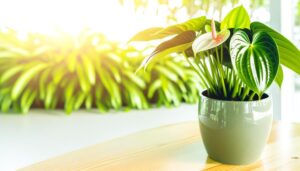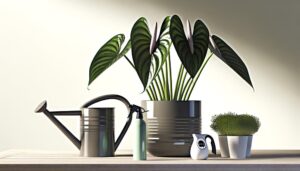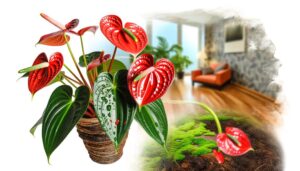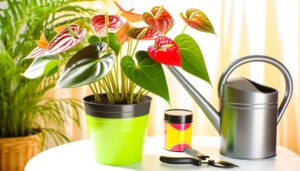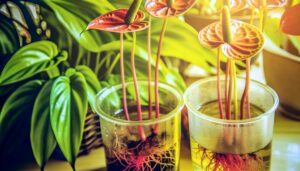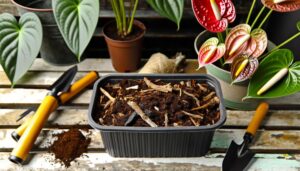Optimal Soil Mix for Anthurium Pedatoradiatum: A Comprehensive Guide
For the best Anthurium pedatoradiatum growth, use a soil mix with 40% orchid bark, 30% perlite, 20% peat moss, and 10% coconut coir. This combination ensures outstanding aeration, drainage, and moisture retention.
Thoroughly mix and moisten the components before planting. Regularly check soil moisture and only water when the top inch is dry to avoid waterlogging.
Place the plant in bright, indirect light and maintain humidity levels between 60-80%. Temperatures should stay between 65-75°F (18-24°C).
For continued healthy growth, there are more specific care guidelines to follow.
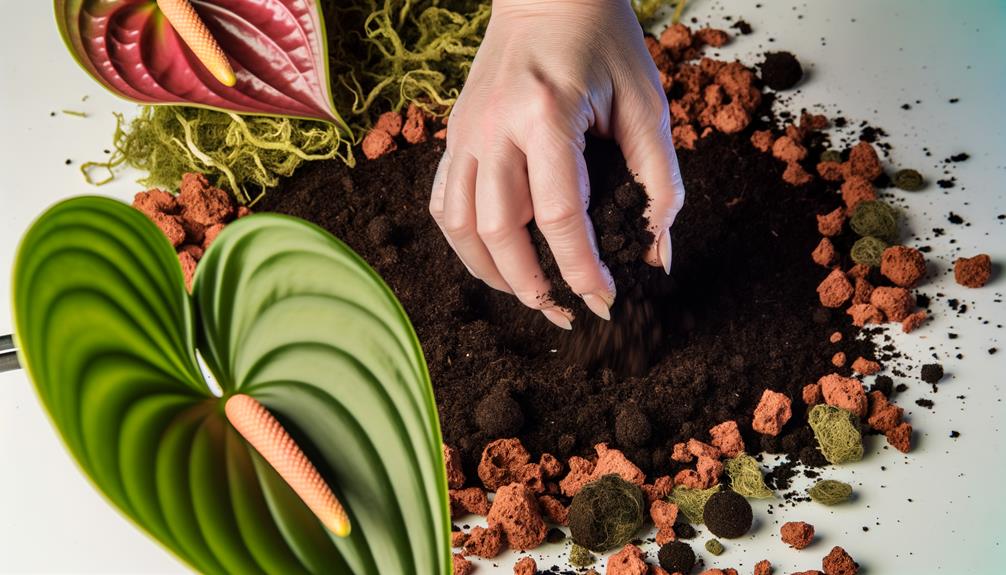
Key Takeaways
- Use a soil mix with 40% orchid bark, 30% perlite, 20% peat moss, and 10% coconut coir.
- Ensure the soil mix is well-aerated for optimal root oxygen access.
- Prioritize excellent drainage to prevent waterlogging and root rot.
- Maintain soil moisture retention with peat moss and coconut coir.
- Regularly check the soil mix for proper drainage and moisture balance.
Understanding Anthurium Soil Needs
To cultivate Anthurium Pedatoradiatum successfully, you need to understand its specific soil requirements that ensure proper aeration, drainage, and nutrient availability.
First, make sure the soil mix is well-aerated. This helps the roots access oxygen, which is vital for their metabolic processes.
Next, prioritize excellent drainage to prevent waterlogging, which can lead to root rot. The soil should allow excess water to flow away easily, maintaining a balance between moisture and dryness.
Finally, nutrient availability is crucial. The soil should be rich in organic matter, providing a steady supply of nutrients to support the plant's growth and health.
Key Soil Components
Understanding the specific soil needs of Anthurium Pedatoradiatum leads us to identify the key components that create an ideal growing medium. You need a mix that ensures proper aeration, drainage, and nutrient availability. Critical components include:
- Orchid Bark: Provides excellent aeration and mimics the plant's natural epiphytic habitat.
- Perlite: Enhances drainage and reduces soil compaction, preventing root rot.
- Peat Moss: Retains moisture while offering an acidic pH suitable for Anthuriums.
- Coconut Coir: Acts as a sustainable alternative to peat moss, maintaining moisture and improving soil structure.
Each component plays a crucial role in creating a balanced, well-draining mix that supports healthy root development and vigorous growth. You'll achieve optimal results by incorporating these elements into your soil blend.
Ideal Soil Ratios
Achieving the ideal soil mix for Anthurium Pedatoradiatum requires precise ratios of orchid bark, perlite, peat moss, and coconut coir to guarantee excellent aeration, drainage, and moisture retention.
Start with 40% orchid bark; its coarse structure ensures robust aeration and prevents root rot.
Next, incorporate 30% perlite, a lightweight volcanic glass that enhances drainage and minimizes waterlogging.
Add 20% peat moss for its superior moisture-holding properties; it maintains a consistent moisture level.
Finally, include 10% coconut coir, a sustainable alternative to peat, which provides additional moisture retention and aeration.
This balanced mix creates an optimal environment for Anthurium Pedatoradiatum, promoting healthy root development and overall plant vitality.
Always measure components accurately to maintain these crucial proportions.
Preparing the Soil Mix
Now that you have the perfect ratios, let's proceed with mixing the components to create the best soil blend for Anthurium Pedatoradiatum. Start by gathering your materials and tools, making sure they're clean and free of contaminants. Follow these steps:
- Combine the predetermined amounts of sphagnum peat moss, perlite, and pine bark fines.
- Mix thoroughly in a large container to guarantee even distribution.
- Moisten the mix slightly to enhance cohesion and facilitate planting.
- Check the mixture's drainage by adding water and observing the flow rate; adjust components if necessary.
Maintain a balance between aeration and water retention to mimic the plant's natural habitat. This precision guarantees your Anthurium Pedatoradiatum thrives in an ideal environment, promoting healthy root development and robust growth.
Tips for Ongoing Care
Maintaining ideal care for your Anthurium Pedatoradiatum involves carefully monitoring light levels, humidity, and watering practices. Position the plant in bright, indirect sunlight to prevent leaf scorch. Maintain humidity around 60-80% to replicate tropical conditions, using a humidifier if needed. Water when the top inch of soil feels dry, guaranteeing proper drainage to prevent root rot.
| Care Aspect | Ideal Condition | Practical Advice |
|---|---|---|
| Light | Bright, indirect | Avoid direct sunlight to prevent leaf burn |
| Humidity | 60-80% | Use a humidifier or pebble tray |
| Watering | When top inch is dry | Ensure good drainage, avoid waterlogging |
| Temperature | 65-75°F (18-24°C) | Keep away from drafts and temperature swings |
Regularly check for pests and prune dead leaves.
Conclusion
To conclude, choosing the best soil blend for your Anthurium pedatoradiatum guarantees its success. Mixing coco coir, perlite, and pine bark in specific ratios enhances excellent oxygen levels, drainage, and nourishment.
Prepare the blend carefully, monitor moisture levels, and stick to a regular care schedule. By mastering these techniques, you'll enhance your plant's capacity, promoting lush foliage and robust health.
Your Anthurium will flourish, all thanks to your considerate, customized, and persistent care.

